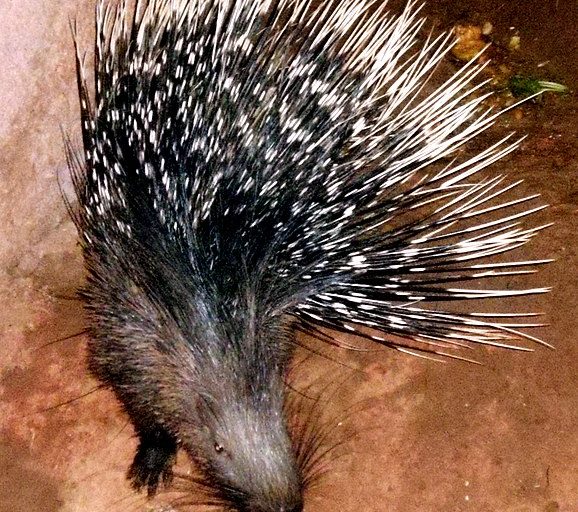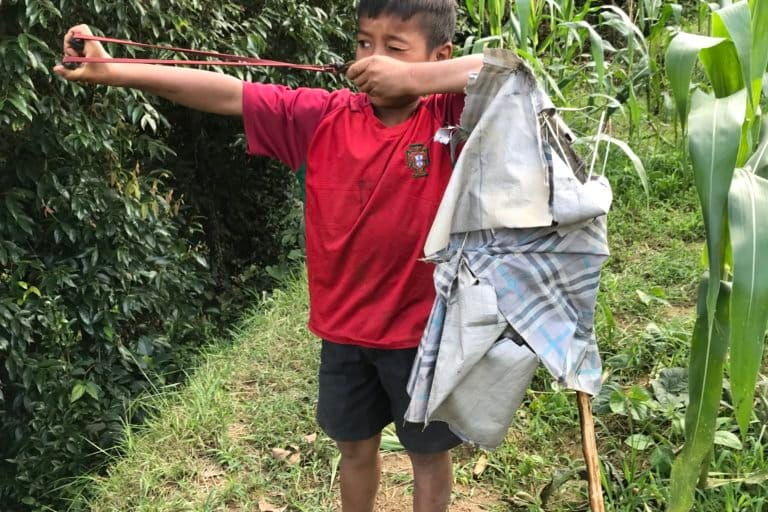
- Farmers in Nepal’s middle hills say monkeys are raiding their crops during the day, followed by porcupines at night.
- Nepal has paradoxically seen an increase in reported cases of human-wildlife conflict as its forest cover has grown dramatically.
- A key reason may be because the trees being planted under the community forestry program are non-native species that don’t provide the fruits that monkeys and porcupines typically eat.
- However, there’s debate on just how common crop raiding is, with researchers saying there needs to be more studies and fewer anecdotes to identify the scale of the problem.
KATHMANDU — Ram Prasad Paudel of Maramche village in Nepal’s Gandaki province decided not to grow maize on his farm this spring. He opted for green vegetables, instead.
“But I am not sure if the vegetables will survive,” says the 70-something Paudel.
Maramche sits in the Cherapunji region, one of the wettest places on Earth. Residents say they’ve learned to live with the heavy rains that fall here throughout the year, but another “menace” keeps them awake at all hours.
“During the day, it’s the monkeys that raid the field, at night it’s the turn of the porcupines,” Paudel says. “Villagers guard their crops during the day to drive away monkeys. But when it’s dark, the porcupines come and eat the crops and we can’t do anything about it.”
Stories such as this have been widely reported in Nepal’s middle hills, an area emblematic of both the government’s community forestry programs and outmigration by young people. Reforestation programs have been underway here for decades; at the same time, thousands of youths have left the area for the cities, even going abroad in search of better wages, education and health facilities. As this diaspora has grown, its members have sent money back to their families left in the villages, who in turn have become less reliant on forest products and have abandoned their farmlands.

This combination has resulted in Nepal’s forest cover bucking global trends, expanding from 26% of the country’s total area in 1992 to 45% in 2016.
Paradoxically, however, more forests and fewer people in them have given rise to an increase in human-wildlife conflict, according to farmers like Paudel.
Sabina Koirala, who recently completed her Ph.D. in human-monkey conflict, says she believes Nepal’s reforestation policies may, in fact, have contributed to the problem of monkeys and porcupines raiding crops today.
“During the ’70s, a massive push for agriculture resulted in large-scale deforestation in Nepal’s hills,” she says. “To counter this, the government introduced the community forestry program. Pine trees native to Australia were the government’s choice as they would remain green throughout the year and grow very fast. They could show the progress real quick.”

But they missed an important point: Native forests provide wild fruit and other food for animals like monkeys, while monocrop pine forests don’t, Koirala says. Decades later, as the area of forest cover greatly increased, it didn’t actually create suitable habitat for all of the local wildlife.
“This may be the reason why animals such as monkeys are forced to wander into human settlements in search of food,” Koirala says.
Mukesh Chalise, who has been studying Nepal’s monkeys for decades, says he doesn’t believe the issue is quite as clear-cut.
“Firstly, it may not be true that incidents of monkey and porcupine conflict have increased compared to the past,” he says. “People usually tend to exaggerate when reporting cases of conflict. For example, if a gang of monkeys raided their field 10 years ago, people would still go around saying that monkeys frequent their fields.”
Chalise also points to the proliferation of mobile phones over the years, which allows people to take pictures instantly and makes it easier for media outlets to report on the issue.
“There is also not enough baseline to data to conclusively say that such incidents have increased,” he says.

As most of the studies are based on anecdotes, it’s also difficult to ascertain which species of monkeys or porcupines are involved in raiding crops. There are three monkey species native to this region of Nepal — the Rhesus macaque (Macaca mulatta), Assam macaque (Macaca assamensis) and Nepal gray langur (Semnopithecus schistaceus) — and two species of porcupines: the Malayan porcupine (Hystrix brachyura) and the Indian crested porcupine (Hystrix indica). Macaques are at the center of most of the reports of crop raiding.
Chalise says that if the number of such incidents has really increased, then it’s because the animals have become habituated to human food.
“When there was a massive push for agriculture in the hills, the farmlands had reached the fringes of the forests and this made it easier for monkeys to eat crops planted by humans,” he says. Now that the farms have been abandoned and wild plants are growing on them, the wildlife, habituated to human food, are also moving to places where they can find such food, Chalise says. He adds he also believes a lack of food sources in the wild is at the root of the problem.
Chalise says the actions of the monkeys help the porcupines, which can’t climb up maize stalks. The monkeys fell the stalks during the day, making it easier for the porcupines to eat the grains at night, he says.

Both Koirala and Chalise say they believe there are no quick fixes to the problem, since both monkeys and porcupines adapt to changing environments quickly. Some municipalities have fired guns in the air to scare the animals away, while others have encouraged farmers to grow citrus fruits as it’s believed that monkeys don’t like them. But these have all been to no avail.
For Koirala, introducing programs to nurture native species of fruits and other plants eaten by wild animals in the country’s forests is the key. “It might not be an overnight fix, but this could eventually help in the long run,” she says.
But for Chalise, getting accurate scientific baseline data on the situation is more important. “We can’t address the problem without understanding its nature and extent,” he says.
Following widespread media reporting on the issue, the government has been working to introduce a scheme that would compensate farmers whose crops are raided by monkeys. Until now, monkeys were not on the list of animals whose crop-raiding was covered under the government’s compensation program.
But that changes little for Paudel from Maramche. “Even if we get compensation, it will take months for the officials to assess the damage, file a report and finally provide us the money,” he says.
Banner Image: A monkey seen on a tree in Panauti, Kavre, Nepal. Image courtesy Sabina Koirala.
Feedback: Use this form to send a message to the author of this post. If you want to post a public comment, you can do that at the bottom of the page.
Monkeys, porcupines team up to destroy crops, Nepal’s farmers say
Source: Trends News

0 Comments